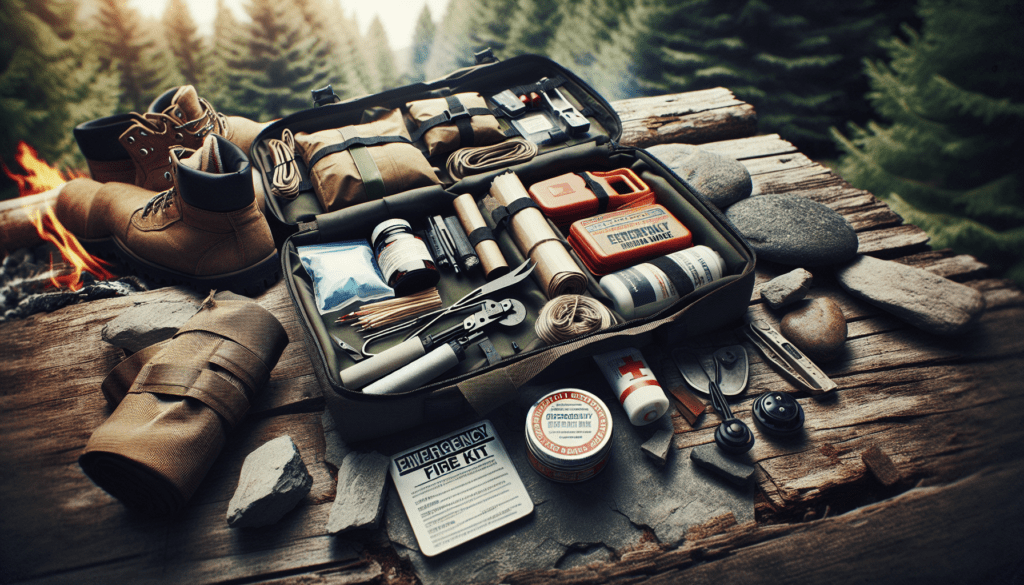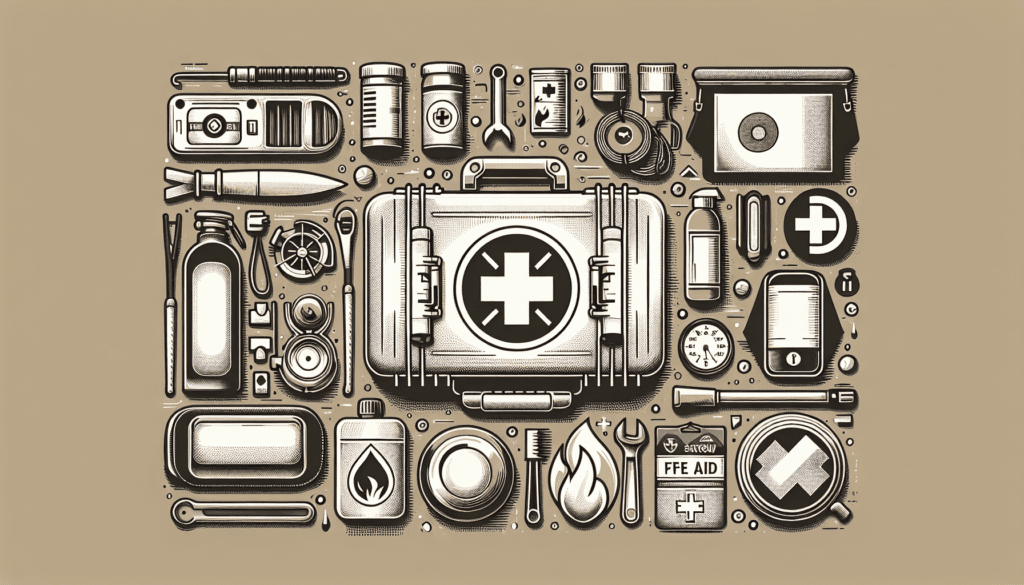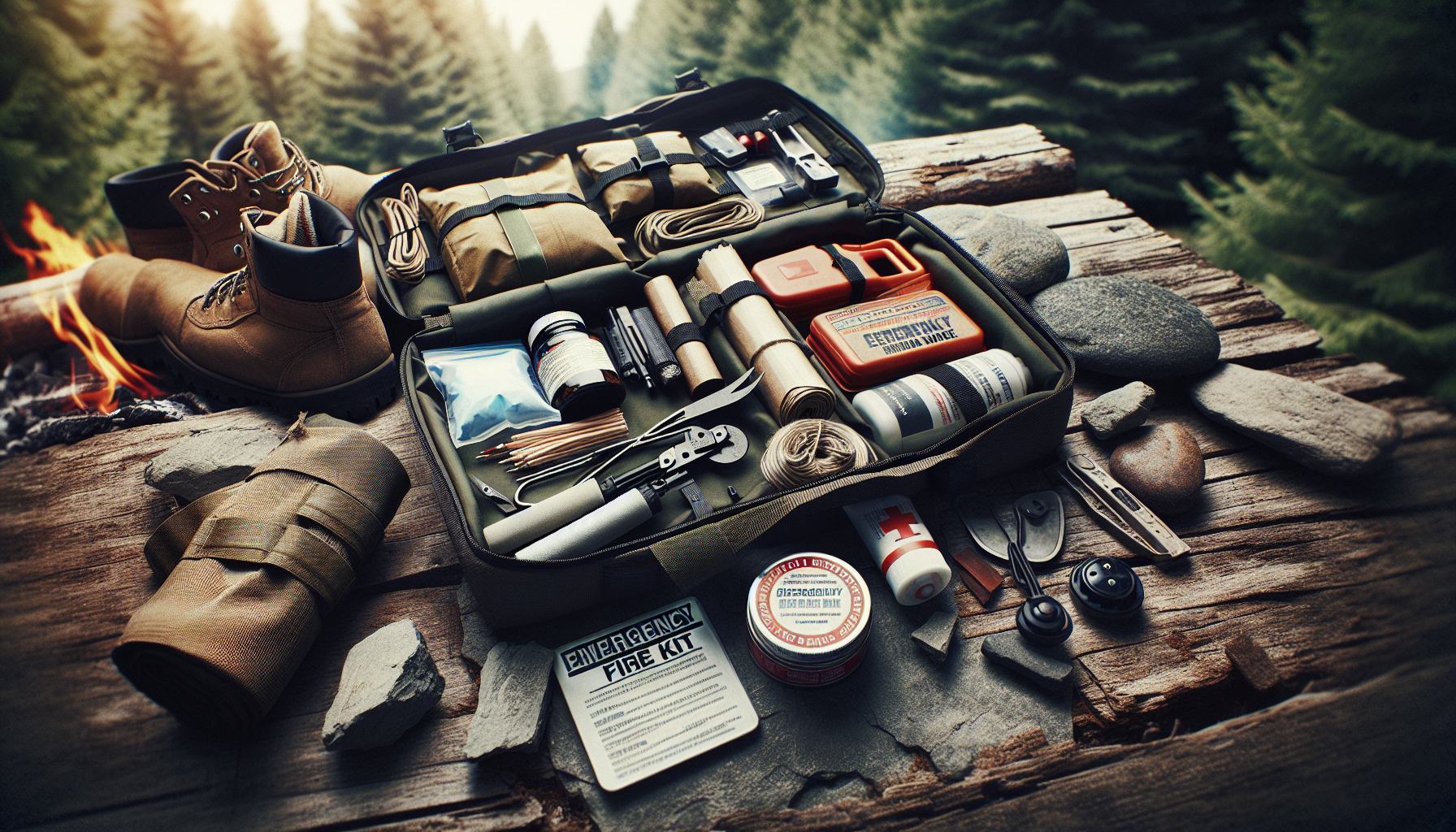Imagine being stranded in the wilderness with no access to electricity or warmth. In such dire situations, having the right tools at hand can mean the difference between life and death. That’s why it is crucial to have a well-prepared Emergency Fire Kit, ready to ignite in an instant. In this article, we will guide you through the essential items you need to include and the steps to take in order to build your own reliable and efficient fire kit. So, whether you’re an avid outdoors enthusiast or someone who simply wants to be prepared for any unexpected emergencies, read on to discover how you can create a fire kit that will keep you warm, safe, and ultimately, save your life.

Selecting the Right Container
When it comes to building an emergency fire kit, one of the first things you need to consider is selecting the right container. The container you choose should not only be able to hold all the necessary fire-building supplies but also be able to protect them from external elements. Look for containers made from waterproof and fireproof materials to ensure that your supplies stay safe even in adverse conditions.
Additionally, durability and lightweight are important factors to consider. You want a container that can withstand the rigors of outdoor adventures without weighing you down. Opt for containers made from sturdy materials like metal or hard plastic, while still being lightweight enough to carry comfortably.
Finally, an airtight seal is crucial to prevent moisture from seeping into your fire-building supplies. Moisture can make it difficult to start a fire, so make sure the container you choose has a tight seal to keep your supplies dry.
Choosing Fire-Starting Tools
Having the right fire-starting tools is essential when building an emergency fire kit. Here are a few options to consider:
Waterproof matches
Make sure to include waterproof matches in your fire kit. Regular matches can easily become useless if they get wet, but waterproof matches are designed to stay dry even in challenging conditions.
Disposable lighters
Disposable lighters are another reliable tool for starting a fire. They are easy to use and compact, making them a convenient addition to your kit. Remember to pack multiple lighters in case one runs out or fails.
Firesteel or ferrocerium rod
A firesteel or ferrocerium rod is a reliable tool for starting fires. When struck with a metal object, such as a knife, it produces sparks that can ignite your tinder material and start a fire. These rods are long-lasting and can work even in wet conditions.
Magnesium fire starter
A magnesium fire starter is another useful tool to consider. It consists of a block of magnesium and a built-in flint. By scraping the magnesium block with a sharp object, you create shavings that can be ignited with the sparks from the flint, providing a hot and intense flame.
Tinder material
Don’t forget to include tinder material in your fire kit. Tinder helps ignite the kindling and serves as the initial fuel for the fire. You can use dry leaves, small twigs, or specialized tinder material like cotton balls soaked in petroleum jelly.
Including Essential Fire-Building Supplies
To build a successful fire in an emergency situation, you’ll need to include the following essential fire-building supplies in your kit:
Dry kindling
Dry kindling is essential for starting a fire. It consists of small sticks, twigs, or wood shavings that catch fire easily. Make sure to pack enough kindling to sustain the initial flame before adding larger firewood.
Firewood
Include enough firewood in your kit to keep the fire burning for an extended period. Choose firewood that is dry and preferably split into smaller pieces for easy ignition and efficient burning.
Firestarter cubes
Firestarter cubes are compact, easily ignitable blocks that provide a long-lasting flame. They can be a convenient and reliable source of fire if you don’t have access to natural tinder.
Cotton balls soaked in petroleum jelly
Cotton balls soaked in petroleum jelly are highly effective fire starters. The petroleum jelly acts as a fuel and helps sustain the flame, making them an excellent addition to any fire kit. They are lightweight, easy to ignite, and burn for a considerable amount of time.
Fatwood sticks
Fatwood sticks, also known as pine knots, contain a high concentration of natural resin that makes them highly flammable. These sticks can be used as both kindling and fire starters, as they catch fire easily and produce a long-lasting flame.
DIY fire starters
For those who enjoy DIY projects, consider creating your own fire starters. You can use materials such as dryer lint, wax-coated cardboard, or even shredded paper soaked in wax. These homemade fire starters are cost-effective and can be customized according to your preferences.
Selecting Essential Fire Safety Equipment
While building a fire kit primarily focuses on fire-starting tools and supplies, it is also crucial to include essential fire safety equipment. Here are a few items to consider:
Fire extinguisher
A fire extinguisher is an essential safety item to have in your fire kit. Look for a compact and lightweight extinguisher that is suitable for extinguishing various types of fires, including those caused by flammable liquids or electrical equipment.
Fire-resistant gloves
Fire-resistant gloves are essential when handling fire and hot objects. They protect your hands from burns and allow you to tend to the fire safely. Look for gloves made from durable, heat-resistant materials, like leather or specialized fire-resistant fabrics.
Fireproof and heat-resistant blanket
A fireproof and heat-resistant blanket can be used to smother small fires or provide protection against heat and flames. These blankets are made from materials that can withstand high temperatures and effectively prevent the spread of fire.
First aid kit
In any emergency situation, having a first aid kit is crucial. Make sure your fire kit includes basic first aid supplies like bandages, antiseptic ointment, and pain relievers. It’s always better to be prepared for any injuries that may occur while building or tending to a fire.

Handling Firewood and Fire-Building Tools
Properly handling firewood and fire-building tools is essential for a safe and successful fire-building experience. Here are a few tips to keep in mind:
Choosing the right firewood
When collecting firewood, opt for dry hardwoods like oak, hickory, or maple. These types of wood burn longer and produce more heat compared to softwoods. Avoid using green or damp wood, as it can be challenging to ignite and produce excessive smoke.
Using a firewood saw
A firewood saw is a valuable tool for cutting larger pieces of firewood into manageable sizes. Use the saw to cut logs into smaller sections, making it easier to light and maintain the fire.
Using a hatchet or axe
A hatchet or axe is useful for splitting larger logs into manageable pieces. This tool allows you to create kindling by splitting the firewood along its grain, making it easier to ignite.
Using a fire poker or tongs
Fire pokers or tongs are handy tools for rearranging burning logs, adjusting the fire’s intensity, or adding more firewood. Use these tools to manipulate the fire safely and keep it burning efficiently.
Packaging Fire-Building Supplies Properly
Proper packaging of your fire-building supplies is vital to ensure their durability and effectiveness. Here are a few ways to package your supplies properly:
Using waterproof bags
Waterproof bags are essential for protecting your fire-building supplies from moisture and rain. Use waterproof bags to store tinder material, firestarter cubes, and any other items that are susceptible to moisture damage.
Using plastic or airtight containers
Plastic or airtight containers are ideal for storing fire tools like matches, lighters, and fire steel rods. These containers prevent moisture from reaching your tools, keeping them dry and functional.
Organizing supplies in labeled compartments
To stay organized, consider using compartments or dividers within your container. Label each section to easily locate specific items when needed. This organization will also help you ensure that no essential items are left behind.
Tips for Fire Kit Maintenance
Maintaining your fire kit is as important as building it in the first place. Here are a few tips for keeping your fire kit in optimal condition:
Regularly check and replace expired items
Inspect your fire kit periodically and check for expired items such as matches or firestarter cubes. Discard any expired items and replace them with fresh ones to ensure reliability in an emergency.
Rotate and replenish supplies as needed
Keep track of your fire-building supplies and rotate them regularly. Replace any supplies that have been used or depleted to ensure you always have a fully stocked and functional fire kit.
Keep the fire kit in a cool and dry place
To prevent moisture damage and preserve the effectiveness of your fire-building supplies, store your fire kit in a cool and dry place. Avoid exposing it to extreme temperatures or direct sunlight, as these can degrade certain items.
Inspect and clean the container
Regularly inspect the container that holds your fire kit for any signs of damage or wear. If necessary, clean the container to remove dirt or debris that could affect the functionality of your fire tools.
Practice using the fire-building tools
Familiarize yourself with the tools in your fire kit by practicing using them before you actually need to start a fire. This will help you become proficient in using each tool and build confidence in your fire-building abilities.
Additional Considerations for Different Environments
The environment in which you plan to use your fire kit can vary greatly. Here are some additional considerations for different environments:
Cold and snowy conditions
In cold and snowy conditions, it’s essential to prioritize fire-starting tools and supplies that can withstand extreme temperatures. Pack extra firewood and use additional insulation, such as rocks or a snow wall, to protect the fire from wind.
Wet and rainy environments
In wet and rainy environments, waterproofing your fire kit becomes even more critical. Ensure that all your supplies are in waterproof containers and bring extra tinder material to compensate for the difficulty of finding dry natural tinder.
Desert or arid regions
In desert or arid regions, fire-starting materials might be scarce. Consider including fire starters that are not reliant on local resources, such as the magnesium fire starter or firestarter cubes.
Forest or wilderness settings
In forest or wilderness settings, fire safety is paramount. Always adhere to fire regulations, obtain necessary permits, and never leave a fire unattended. Pay attention to surrounding vegetation and clear any flammable debris before starting a fire.
Coastal or beach locations
In coastal or beach locations, the presence of wind and saltwater can pose challenges to starting and maintaining a fire. Ensure you have wind-resistant fire starters and build your fire in a protected area to minimize the impact of strong ocean breezes.
Being Mindful of Fire Laws and Regulations
Before starting a fire, it is important to be mindful of the fire laws and regulations in your area. Here are a few guidelines to follow:
Check local regulations
Research and understand the local regulations regarding fires in the area where you plan to use your fire kit. Different regions have specific rules regarding fire sizes, locations, and permits.
Observe fire bans or restrictions
During periods of high fire risk or when fire bans are in effect, it is essential to respect and follow the restrictions. Ignoring fire bans can lead to dangerous situations and have severe environmental consequences.
Avoid causing wildfires
When using a fire kit outdoors, always be mindful of your surroundings and avoid situations that could cause wildfires. Clear flammable debris, keep a safe distance from vegetation, and never leave a fire unattended.
Maintain safety distances
Ensure that your fire is a safe distance away from any buildings, tents, or other flammable objects. Follow guidelines on how far your fire should be from any combustible materials to prevent accidents.
Practicing Safe Fire-Starting Techniques
Practicing safe fire-starting techniques is crucial to minimize the risk of accidents or injuries. Here are a few tips to keep in mind:
Clearing flammable debris
Before starting a fire, clear the area around your fire pit of any flammable debris such as leaves, branches, or dried grass. This will help prevent the accidental spread of fire.
Building a fire pit or designated area
If possible, build or use an existing fire pit or designated fire area. A fire pit helps contain the fire and provides a safer environment for fire-building activities. If there is no designated area, create a cleared space with rocks or a ring of stones to mark the fire zone.
Putting out fires properly
When extinguishing a fire, make sure it is fully extinguished and cold to the touch. Pour water over the fire, stir the ashes, and repeat this process until no heat remains. Never leave a fire unattended or assume it has gone out on its own.
Reporting any emergencies
In case of an emergency or if a fire gets out of control, immediately contact the appropriate authorities and report the situation. Prompt reporting can help prevent further damage and ensure a swift response.
Building an emergency fire kit is essential for anyone venturing into the outdoors. By carefully selecting the right container, choosing reliable fire-starting tools, including essential fire-building supplies, and being mindful of fire safety, you can ensure a safe and efficient fire-building experience in any environment. Prioritize building your fire kit, and remember to practice fire safety at all times. Stay prepared, safe, and warm!

